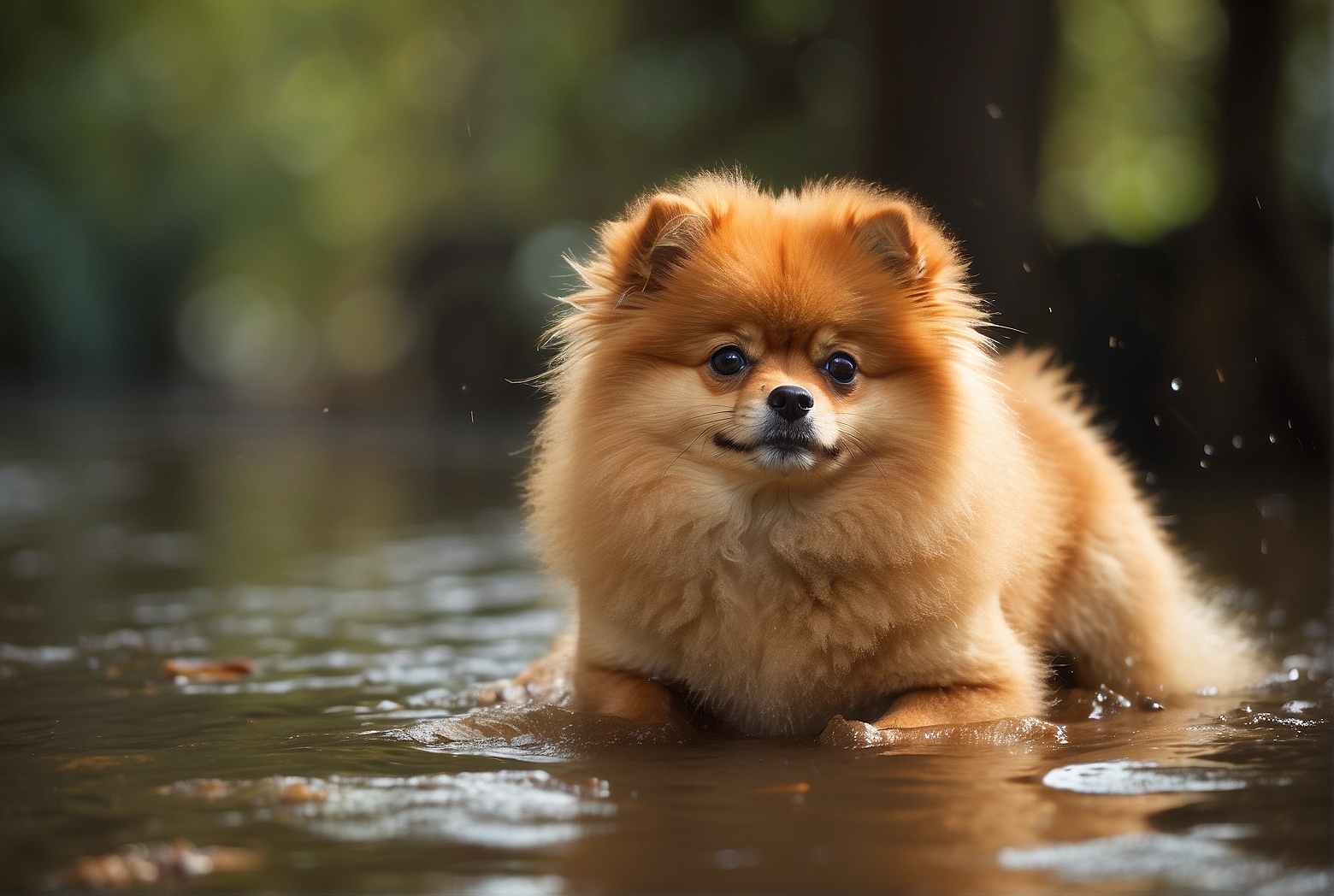Have you ever wondered if Pomeranians have webbed feet? In this article, we will explore the fascinating world of Pomeranian dogs and uncover the truth behind this intriguing question. While webbed feet are commonly associated with certain dog breeds, such as the Labrador Retriever, it remains a mystery whether Pomeranians possess this distinctive feature. Join us on this journey as we discover whether these adorable fluff balls have webbed feet or not.
What are Pomeranians?
Pomeranians are a small toy breed of dog that are known for their friendly and playful nature. They have a fluffy double coat and are often referred to as “poms” for short. Pomeranians are descendants of large sled-pulling dogs from the Arctic, but their size has been selectively bred down over the years to create the small and compact Pomeranian we know today.
History and Origin
Pomeranians have a rich history that dates back several centuries. They are named after the region of Pomerania, which was located in present-day Germany and Poland. Originally, Pomeranians were much larger and were used for herding and pulling sleds. It wasn’t until the 19th century that breeders began to focus on shrinking their size and enhancing their appearance.
Physical Appearance
Pomeranians are small, compact dogs with a distinctive fox-like face. They typically weigh between 3-7 pounds and stand around 6-7 inches tall at the shoulder. Pomeranians have a fluffy double coat that comes in a wide variety of colors, including orange, black, white, cream, and sable. Their tails are plumed and often held high over their backs.
Anatomy of Pomeranians
Structure and Size
Pomeranians have a well-balanced structure despite their small size. They have a compact body with a level topline and a graceful, arched neck. Their heads are wedge-shaped, and their eyes are dark and almond-shaped. Pomeranians have a small, compact chest and a well-feathered tail that is set high.
Coat and Color
One of the most prominent features of Pomeranians is their double coat. The outer coat is long, straight, and harsh, while the inner coat is soft and dense. This combination gives them a fluffy and luxurious appearance. Pomeranians come in a wide range of colors, including solid, parti-color, and merle patterns. The coat color can vary significantly, and some Pomeranians even have a color change as they mature.

Paws and Feet
Pomeranians have small, compact paws with well-arched toes. Their feet are covered in fur, which helps to keep them warm in colder climates. While Pomeranians don’t have webbed feet like some other breeds, their feet are well-designed for walking, running, and exploring various terrains. Their small size and well-padded feet allow them to navigate quickly and easily.
Webbed Feet in Dogs
What are Webbed Feet?
Webbed feet are specialized feet that have extra skin between the toes, creating a web-like structure. This adaptation is commonly seen in breeds that are known for their swimming abilities. The webbing helps to enhance their propulsion and allows for efficient movement in water.
Breeds with Webbed Feet
Several dog breeds are known for having webbed feet. These breeds include the Newfoundland, Labrador Retriever, Chesapeake Bay Retriever, and Portuguese Water Dog. Their webbed feet enable them to be exceptional swimmers and excel in activities such as water retrieving and dock diving.
Advantages of Webbed Feet
Webbed feet provide certain advantages to dogs, especially those who spend a lot of time in or around water. The webbing between the toes increases the surface area of the paws, allowing for better propulsion and more efficient swimming. It also helps to prevent excessive fatigue and aids in maintaining balance and stability while navigating through water.
Pomeranians and Webbed Feet
Scientific Research
In contrast to breeds like the Newfoundland or Labrador Retriever, Pomeranians do not naturally possess webbed feet. Scientific research regarding Pomeranians and webbed feet is limited, as it is not a common characteristic of the breed. However, anecdotal evidence and observations from Pomeranian owners suggest that there may be some variability in foot structure within the breed.
Common Characteristics
While Pomeranians do not have webbed feet, they do share some common characteristics with breeds that do have webbing. For example, many Pomeranians have well-padded and compact feet, which allow for agility and ease of movement. Additionally, some Pomeranians may have slightly longer and more slender feet, potentially increasing their surface area and enhancing their swimming ability to some extent.

Potential Benefits or Drawbacks
In the absence of webbed feet, Pomeranians may not have the same natural ability for swimming as breeds with webbing. However, this does not mean that Pomeranians cannot enjoy water-related activities. With proper supervision and consideration for their small size, Pomeranians can still have fun in shallow water or with the aid of life jackets.
Reasons for Webbed Feet in Pomeranians
Evolutionary Factors
The lack of webbed feet in Pomeranians can be attributed to the selective breeding practices that focused on reducing their size and enhancing their appearance. As their purpose shifted from working dogs to companions, the need for specialized webbed feet became less important. Over time, the genetic traits for webbed feet likely diminished within the Pomeranian breed.
Possible Genetic Influences
It is also possible that the absence of webbed feet in Pomeranians is influenced by the combination of genetic factors that have been selected for throughout their breed development. Breeders have prioritized specific traits such as size, coat color, and temperament, which may have inadvertently resulted in a decrease in the instances of webbed feet.
Misconceptions about Pomeranians and Webbed Feet
Myths and Unverified Information
There are various myths and unverified claims surrounding Pomeranians and webbed feet. Some people believe that all Pomeranians have webbing, while others claim that it is a sign of mixed breeding. However, it is essential to rely on accurate information and scientific evidence rather than perpetuating unfounded myths or assumptions.
Practical Implications of Webbed Feet in Pomeranians
Exercise and Activities
While Pomeranians may not naturally excel in swimming activities due to their lack of webbed feet, they can still engage in other forms of exercise and activities. Pomeranians require regular exercise to stay healthy and mentally stimulated. Activities such as walks, play sessions, and interactive toys can help keep them active and entertained.
Water-related Activities
Although Pomeranians are not typically considered water dogs, they can still enjoy water-related activities under appropriate supervision. It is important to introduce them to water gradually and in a controlled environment. Outfitting them with a well-fitting life jacket can also provide extra safety and buoyancy, allowing them to experience water play with peace of mind.
Care and Maintenance for Pomeranian’s Feet
Nail Trimming
Regular nail trimming is essential for maintaining optimal foot health in Pomeranians. Overgrown nails can cause discomfort, difficulty walking, and even pose a risk for nail breakage. Using appropriate dog nail clippers or seeking professional grooming assistance can help keep your Pomeranian’s nails at an appropriate length.
Regular Inspection
It is important to regularly inspect your Pomeranian’s feet to ensure there are no signs of injury, irritation, or foreign objects. Small mats or tangles between the toes can be gently untangled with a comb or brush to prevent discomfort or potential foot issues. Cleaning the paws after outdoor activities can also help prevent debris from becoming trapped between the toes.
Moisturizing
Pomeranians, like many small breed dogs, can be prone to dry paw pads. Routine moisturizing with dog-friendly paw balms or creams can help keep their paw pads moisturized and prevent cracking. This is particularly important in dry or cold climates when the paw pads are more prone to dryness and damage.
Expert Opinions on Pomeranians and Webbed Feet
Veterinarians’ Perspectives
Veterinarians generally agree that Pomeranians do not naturally possess webbed feet. They emphasize the importance of providing appropriate care, exercise, and supervision to ensure the well-being of Pomeranians during water-related activities. Regular check-ups are recommended to address any potential foot-related issues promptly.
Experienced Breeders’ Insights
Experienced breeders acknowledge that while Pomeranians do not typically have webbed feet, there may be some variations in foot structure within the breed. They stress the importance of prioritizing overall health, quality breeding standards, and responsible ownership when it comes to Pomeranians and their feet.
Conclusion
Understanding Pomeranians and their feet is essential for their overall well-being and optimal care. While Pomeranians do not naturally possess webbed feet like some other breeds, their compact and well-padded feet allow them to navigate various terrains with ease. It is important to provide proper care and maintenance for their feet, as well as consider their individual abilities and needs when engaging in exercise or water-related activities. By debunking misconceptions and relying on accurate information, we can ensure that Pomeranians receive the care and attention they deserve.
